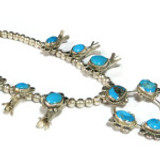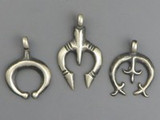blog
What is the "Man in Maze"?
Posted by Claudia on Jun 24th 2015
The “man in the maze” was originally created as an illustration of the emergence story by the Tohono O’odham or Papago Indians of the Central Valley in Arizona. The “man in the maze” is a visual representation of the Tohono O’odham Indians belief in life, death, and the life after death. From family to family, interpretations vary slightly. The hum[…]
Read More »Cleaning a Squash Blossom Necklace
Posted by Claudia on Jun 12th 2015
A common question I often hear is “How do I clean my squash blossom necklace?” This is actually pretty easy to do and there are a few methods that you can use to clean a squash blossom necklace. A friend recently asked me to clean her squash blossom necklace for her so I will show you how I will go about cleaning this for her. This[…]
Read More »What is Liquid Silver Jewelry?
Posted by Claudia on Apr 17th 2015
Liquid silver is often referred to as “liquid heishi” or “silver heishi”. Silver heishi is fine, tubular, silver beads that are hand-strung together in what appears to be seamless strands of silver.When these strands are strung together, liquid silver has a fluid feel almost like silk or water running through your fingers reflecting b[…]
Read More »Sleeping Beauty Turquoise
Posted by Claudia on Jan 30th 2015
What Is Sleeping Beauty Turquoise? Sleeping Beauty turquoise has been revered by man for its ideal, clear, robin’s egg blue color. The Sleeping Beauty turquoise mine has been one of the largest producers of high-quality turquoise in the world. The Sleeping Beauty turquoise mine located in Globe, Arizona has produced a compelling, clear sky-b[…]
Read More »The Naja Pendant
Posted by Claudia on May 15th 2014
Naja Symbol Meaning The naja is a crescent-shaped piece that is often worn alone as a pendant or as the center piece of a squash blossom necklace in Southwestern Indian jewelry. The naja design shape is thought to have originated from the Moorish and then borrowed from the Spanish that was used as an ornamental design on horse bridle head[…]
Read More »Kokopelli
Posted by Claudia on May 1st 2014
One of the most intriguing wide-spread images found in the Southwest is the humpbacked flute player. He is easily recognized by his flute, humped back and prominent phallus. An aura of mystery surrounds Kokopelli: Was he a fertility symbol, roving trader, rain priest, magician, trickster or a seducer of maidens? We know he is quite significantly on[…]
Read More »Rock Art
Posted by Claudia on Feb 13th 2014
Throughout ancient history man has carved or painted on rocks and caves leaving traces of his time and world. Here in the Southwest United States, rock paintings and petroglyphs are known to have a history of about 3,000 years of artistic endeavor by Native American Indians. Rock paintings are usually found on light-colored surfaces such as cl[…]
Read More »






